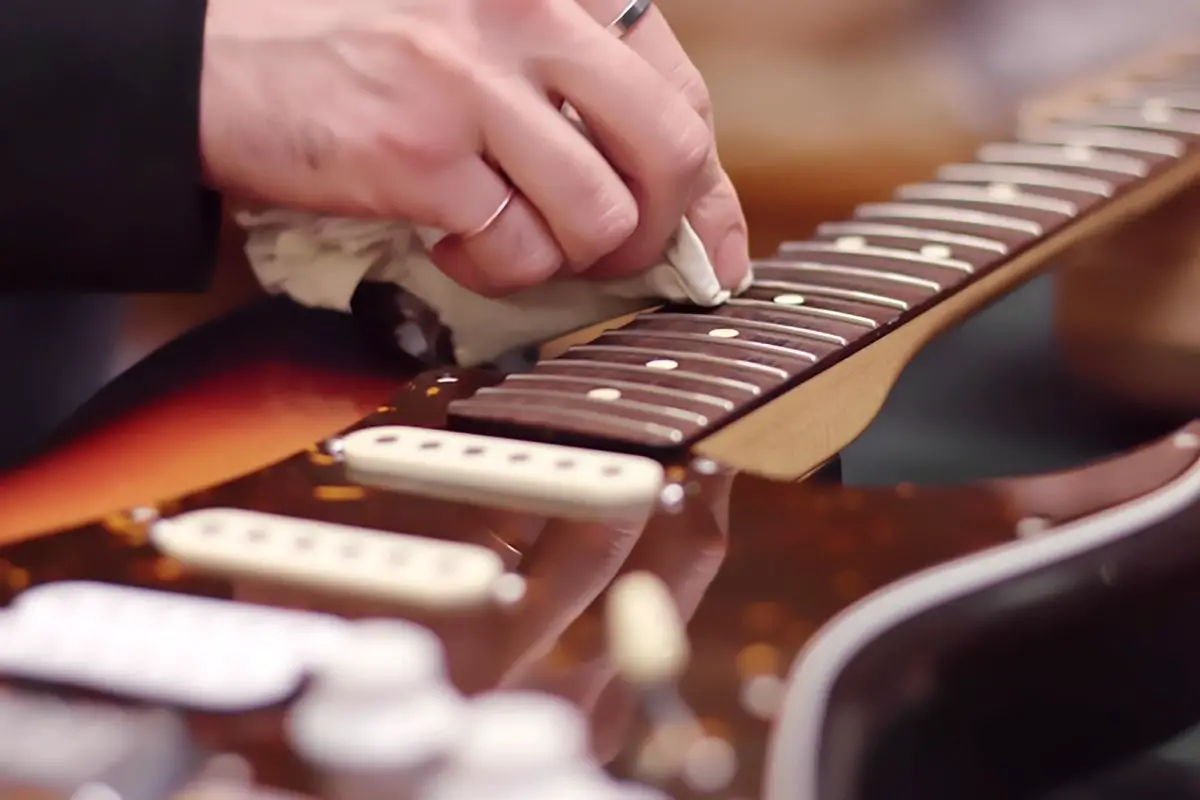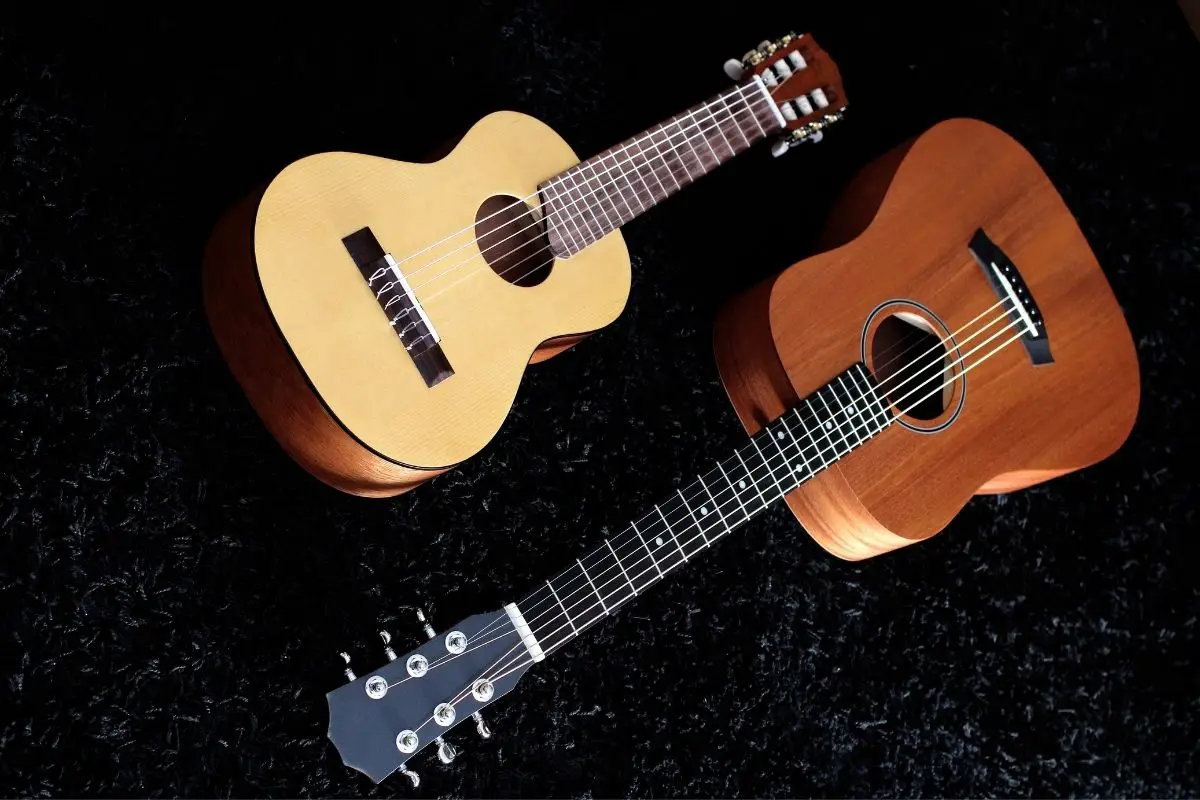Tuning a guitar is an essential skill for any guitarist to learn, and it’s one of the first things you need to know when starting out. This article will teach you how to tune a 12 string acoustic guitar in three easy steps.

Learn About How To Tune A 12 String Acoustic Guitar?
Step 1: Set Your Guitar Up For Tuning
The first step to tuning your guitar is setting up your guitar so that it can be tuned easily. You should set your guitar up as follows:
Make sure the strings are all at the same height (you may have to adjust them). You should also ensure that the nut is facing forward, and the saddle is sitting on the bridge. Adjust the truss rod if necessary.
Step 2: Pick Up All Strings On One Side Of The Neck
Pick up all the strings on one side of the neck by using a pick or finger. If you don’t want to use a pick, then just hold down the string with your thumb and index finger while picking it up with your other fingers.
Step 3: Adjust The First String
Once you’ve picked up all the strings, take note of which string has the lowest pitch. It’s usually the highest pitched string on the top E string.
Now, play this string until it sounds sharp. Once you hear it sound sharp, move your fretboard towards the nut until the string starts sounding flat again. Then, tighten the string until it sounds right.
Step 4: Adjust The Second String
Repeat the process from step 3, but this time start with the second string. Look at the string closest to the nut. That string should be the lowest pitched string.
Play that string until it sounds sharp, then move your fretboard towards your nut until the string starts to sound flat again. Tighten the string until it sounds good.
Step 5: Adjust The Third String
Now repeat the process from step 3 except this time start with the third string. Look at the next lower string. That string should be lower than the previous string.
Play that string and make sure it sounds sharp. Move your fretboard towards the end of the neck until the string starts to feel flat. Tighten the string as needed. Repeat this process for each string until they’re all in perfect tune.
Step 6: Check Out Your Work
You should now have all your strings in tune. Congratulations! Now you have what it takes to become a great guitar player.
Difference Between 6 and 12-String Guitar Tuning
There are two different types of tuning for guitars: 6 and 12 string. Both have their own advantages and disadvantages.
6-String Guitar Tuning
A six-string guitar is tuned like a regular guitar, where the low E string sits between the high E and B strings. This type of tuning is most commonly used when playing rock music.
Pros:
- Easy to learn and great for beginners.
Cons:
- Not very versatile.
12-String Guitar Tuning
A twelve-string guitar is tuned differently from a regular guitar. Instead of having three pairs of strings, there are four pairs. The first pair consists of an octave higher string than the others.
The second pair consists of a fifth above the fourth pair. The third pair consists of a sixth above the fifth pair. And finally, the last pair consists of a seventh above the sixth.
This type of tuning is more difficult to master because you need to know how to properly adjust the tension of the strings. You also need to know how to use the open chords correctly.
Pros:
- More challenging and versatile.
Cons:
- Takes longer to learn.
What Notes Should I Tune A Guitar To?
When choosing which notes to tune your guitar to, you’ll want to consider several factors. First, you should select a key that’s easy to remember.
For example, if you plan to play blues or jazz, you might want to select C Major or G Major. If you plan to play country, you might want to pick a D Major.
Next, you’ll want to decide whether you want to play major or minor scales. A major scale has seven notes, while a minor scale has five.
Finally, you’ll want to think about what kind of music you plan to play. Are you going to play pop songs? Rock songs? Blues songs? Country songs? Jazz? Classical? Whatever genre you select, you can’t go wrong by starting off with the right note range.
How Do I Prevent My Guitar From Becoming Damaged?

Some people find that when they try to tune their guitar strings, they snap. It happens because the strings get too tight. There are many ways to prevent this problem.
1. You can loosen up the strings before you begin tuning them. Simply pull back on the strings and then tighten them again once you’ve finished tuning.
2. You can wrap some electrical tape around the strings near the nut. Tape will help keep the strings from snapping during tuning.
3. You can put a piece of paper under the strings as you’re tightening them. Paper helps keep the strings from snapping.
4. You can use a locking wrench to keep the strings from slipping. Locking wrenches come in various sizes. Choose one that fits the size of your strings.
5. You can use a small amount of thread sealer to lubricate the strings. Thread sealer keeps the strings from getting too slippery.
6. You can use graphite paste to make the strings less slippery. Graphite paste comes in different colors. Use whichever color matches your guitar’s finish.
7. You can use a guitar oil to keep the strings from drying out. Some guitar oils contain antioxidants. These antioxidants protect the strings from breaking down over time.
8. You can use a water-soluble lubricant such as WD-40. WD-40 works well for keeping guitar strings clean and free of dirt.
9. You can use a grease gun to apply grease to the strings. Grease guns usually have two settings. One setting applies grease to the strings. The other setting sprays the area where the strings meet the frets.
10. You can use an electric string trimmer to cut away excess string material. Electric string trimmers work very well at cutting through the strings without damaging the guitar body.
11. You can use waxed cotton balls to keep the strings from sticking together. Waxed cotton balls are available in different colors. Each color corresponds to a particular type of string.
12. You can use a polishing cloth to polish the strings. Polishing cloths come in different shapes and sizes. Choose one that is large enough to cover all the strings.
13. You can use a toothbrush to brush the strings. Toothbrushes come in different types and sizes. Select one with soft bristles.
14. You can use a file to smooth down the fretboard. File the fretboard, so it has no sharp edges or rough spots. This prevents the strings from catching on the fretboard.
15. You can use a pick to remove any burrs or nicks from the fretboard. Picks come in different styles and materials. Pick up a style that feels comfortable in your hand.
16. You can use a fine sandpaper to smooth down the fretboard. Sandpapers come in different grit levels. Select a level that removes surface scratches but doesn’t scratch the wood.
17. You can use a buffer to buff down the fretboard. Buffers come in different sizes and shapes. Choose one that is long enough to reach across the entire length of the fretboard.
18. You can use a drum pad to dampen the strings. Drum pads are available in different sizes. Select one that covers most of the strings.
19. You can use a pencil to draw lines along the neck. Draw lines between the positions of the frets. This helps you find the correct pitch when tuning the guitar.
20. You can use a screwdriver to tighten the screws that hold the saddle in place. Screwdrivers come in different sizes and designs. Select one that fits comfortably in your hand.
21. You can use a small hammer to tap out the sound hole. Tapping out the sound hole makes sure that there is nothing obstructing the sound hole.
22. You can use a flathead screwdriver to loosen the screws that hold the tuner in place. Flathead screwdrivers come in different sizes. Pick a size that fits comfortably in your palm.
23. You can use a Phillips head screwdriver to tighten the nuts that hold the tuning pegs in place. Phillips head screwdrivers come in different shapes and designs. Pick one with a curved tip for easier access.
24. You can use a wrench to tighten the bolts that hold the tuning machine in place. Wrenches come in different sizes and styles. Choose one that fits securely in your hand.
25. You can use pliers to adjust the tension of the strings. Pliers come in different designs and sizes. Choose ones that feel comfortable in your hand. Use them to turn the string until it’s tight, then pull it off the peg.
26. You can use a soldering iron to solder the wires together. Soldering irons come in different sizes and temperatures. Select one that has a temperature setting that matches the type of wire you’re working with.
What Are The Benefits Of Tuning A 12-String Guitar?
1. It gives you more flexibility on how you play. With a 12-string guitar, you can play chords or single notes without having to change strings.
2. It allows you to play faster than if you were playing only 6 strings. Because you have fewer strings to fret, you don’t need to press down harder on each note.
3. It adds an extra dimension to your music. Playing a tuned 12-string guitar opens up new possibilities for creating unique sounds.
4. It makes your music more interesting. When you add another string to your instrument, you get a richer tone. Your sound becomes fuller, deeper, and richer.
5. It’s fun! Playing a 12-string is like playing two guitars at once. You’ll be able to play fast rhythms and melodies.
6. It’s easy to learn. If you’ve never played a 12-string before, it may take some practice to master the technique. But after you do, you’ll find yourself enjoying this musical style.
7. It’s versatile. You can play any kind of music using a 12-string. Whether you want to rock out or create classical pieces, a 12-string is ready to go.
Conclusion
To conclude, you can easily tune a 12-string guitar by following the simple instructions above. Once you know how to tune a 12-string guitar, you’ll be able to enjoy playing all kinds of musical genres.
You should ensure that you are not roughly handling your guitar during the tuning process as guitar strings can snap easily. To avoid your strings snapping, you should dampen them prior to tuning and ensure that you are paying attention during the process.
You should avoid tuning your 12-string guitar when you are feeling frustrated as it is a delicate task that requires patience.
It is important to note that the benefits of tuning your guitar outweigh any effort involved as you will be able to play songs beautifully without any deadened sounds ruining your performance.
FAQ
Can You Put 6 Strings on a 12 String Guitar?
If you already have a 12-string guitar and are wondering if you can put 6-strings, the answer is yes. It’s possible to do this and still enjoy playing your guitar. It will, of course, feel different due to the wider fretboard and fear strings than usual.
However, the wider empty space offers some benefits. You will have more space for your fingers to move between the strings. That also translates to a more comfortable feeling when playing.

My name is Howard Matthews and I have been playing the guitar since I was knee-high. My parents like to joke that I was pulling the strings even before I was born. In fact, one of my earliest memories is sitting on the couch with my dad’s guitar, wreaking havoc on the chords.
Now, 40 years later, I can attest that I play them much better than I did back then. I have followed in the footsteps of both my parents – much to their delight – and have been the main guitarist in my band for the best part of three decades.
Music has always been my passion, and until recently my life has been so consumed with it that I haven’t had a moment to have a breath (and I wouldn’t have it any other way)!








